国际经济学(国际金融部分)
国际经济学习题(国际金融)
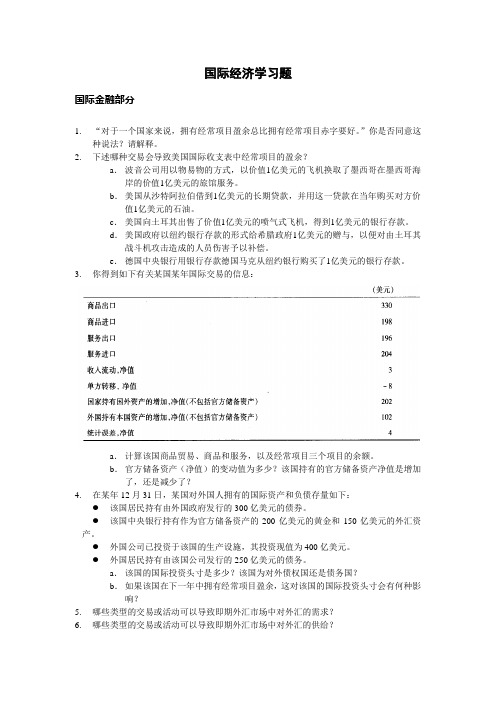
国际经济学习题国际金融部分1.“对于一个国家来说,拥有经常项目盈余总比拥有经常项目赤字要好。
”你是否同意这种说法?请解释。
2.下述哪种交易会导致美国国际收支表中经常项目的盈余?a.波音公司用以物易物的方式,以价值1亿美元的飞机换取了墨西哥在墨西哥海岸的价值1亿美元的旅馆服务。
b.美国从沙特阿拉伯借到1亿美元的长期贷款,并用这一贷款在当年购买对方价值1亿美元的石油。
c.美国向土耳其出售了价值1亿美元的喷气式飞机,得到1亿美元的银行存款。
d.美国政府以纽约银行存款的形式给希腊政府1亿美元的赠与,以便对由土耳其战斗机攻击造成的人员伤害予以补偿。
e.德国中央银行用银行存款德国马克从纽约银行购买了1亿美元的银行存款。
3.你得到如下有关某国某年国际交易的信息:a.计算该国商品贸易、商品和服务,以及经常项目三个项目的余额。
b.官方储备资产(净值)的变动值为多少?该国持有的官方储备资产净值是增加了,还是减少了?4.在某年12月31日,某国对外国人拥有的国际资产和负债存量如下:●该国居民持有由外国政府发行的300亿美元的债券。
●该国中央银行持有作为官方储备资产的200亿美元的黄金和150亿美元的外汇资产。
●外国公司已投资于该国的生产设施,其投资现值为400亿美元。
●外国居民持有由该国公司发行的250亿美元的债务。
a.该国的国际投资头寸是多少?该国为对外债权国还是债务国?b.如果该国在下一年中拥有经常项目盈余,这对该国的国际投资头寸会有何种影响?5.哪些类型的交易或活动可以导致即期外汇市场中对外汇的需求?6.哪些类型的交易或活动可以导致即期外汇市场中对外汇的供给?7.一家美国公司购买了一家日本公司的产品,因而必须向其支付100万日元。
美国公司以美元支票账户开始进行这一支付。
请解释这笔支付将如何进行,包括对即期外汇市场和两国银行的使用。
8.一家英国银行在与其客户的交易中得到一大笔美元,如果这家银行不愿继续持有这些美元,它将如何利用银行间外汇交易市场。
克鲁格曼《国际经济学》(国际金融)习题答案要点
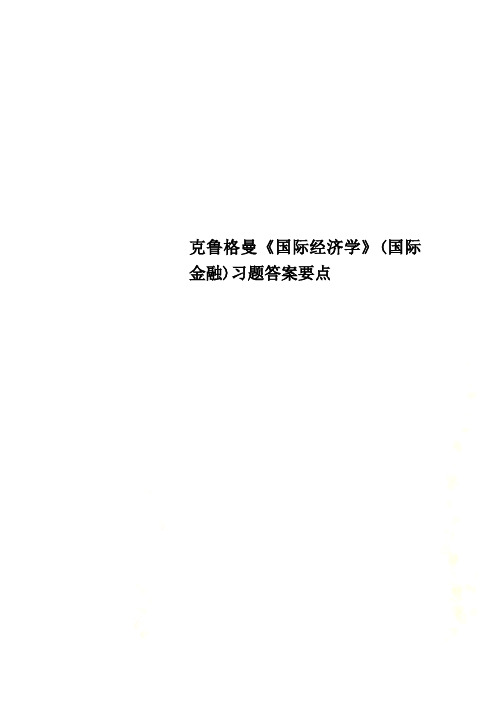
克鲁格曼《国际经济学》(国际金融)习题答案要点赤字。
因此,1982-1985年美国资本流入超过了其经常项目的赤字。
第13章 汇率与外汇市场:资产方法 1、汇率为每欧元1.5美元时,一条德国香肠bratwurst 等于三条hot dog 。
其他不变时,当美元升值至1.25$per Euro, 一条德国香肠bratwurst 等价于2.5个hot dog 。
相对于初始阶段,hot dog 变得更贵。
2、63、25%;20%;2%。
4、分别为:15%、10%、-8%。
5、(1)由于利率相等,根据利率平价条件,美元对英镑的预期贬值率为零,即当前汇率与预期汇率相等。
(2)1.579$per pound6、如果美元利率不久将会下调,市场会形成美元贬值的预期,即e E 值变大,从而使欧元存款的美元预期收益率增加,图13-1中的曲线I 移到I ',导致美元对欧元贬值,汇率从0E 升高到1E 。
131-图 7、(1)如图13-2,当欧元利率从0i 提高到1i 时,汇率从0E 调整到1E ,欧元相对于美元升值。
I 'IE 1E $/euroE图13-2(2)如图13-3,当欧元对美元预期升值时,美元存款的欧元预期收益率提高,美元存款的欧元收益曲线从I '上升到I ,欧元对美元的汇率从E '提高到E ,欧元对美元贬值。
133-图8、(a)如果美联储降低利率,在预期不变的情况下,根据利率平价条件,美元将贬值。
如图13-4,利率从i 下降到i ' ,美元对外国货币的汇价从E 提高到E ',美元贬值。
如果软着陆,并且美联储没有降低利率,则美元不会贬值。
即使美联储稍微降低利率,假如从i 降低到*i (如图13-5),这比人们开始相信会发生的还要小。
同时,由于软着陆所产生的乐观因素,使美元预期升值,即e E 值变小,使国外资产的美元预期收益率降低(曲线I 向下移动到I '),曲线移动反映了对美国软着陆引起的乐观预期,同时由乐观因素引起的预期表明:在没有预期变化的情况下,由利I 'E E 'euro/$E IiE 1E euro/$E rate of return(in euro)0i 1i率i 下降到*i 引起美元贬值程度(从E 贬值到*E )将大于存在预期变化引起的美元贬值程度(从E 到E '')。
《国际金融学》课程教学大纲

《国际金融学》课程大纲课程代码:04154005课程学分:3课程总学时:48适用专业:经济与金融专业一、课程概述(一)课程的性质《国际金融》课程,是教育部确定的“财经类专业核心课程”之一,该课程不仅是院校本科层次各专业统一开设的专业基础课和必修课,而且是金融、经济与金融专业的主干课程和基础理论课程。
国际结算、西方金融理论、外汇风险管理等涉及国际金融专业的课程都是在国际金融的基础上发展而来的。
国际金融以开放经济学为基础,研究开放经济发展中的核心问题国际收支、外汇、汇率、外汇市场、汇率制度、外汇管制、国际储备、国际金融市场、国际金融风险管理、国际资本流动与国际金融危机、国际货币体系和国际金融机构等问题,在经济、金融理论研究领域中具有举足轻重的地位。
(二)设计理念与开发思路1、促进学习者理解和重点掌握国际收支、外汇、汇率、外汇市场、汇率制度、外汇管制、国际储备、国际金融市场、国际金融风险管理、国际资本流动与国际金融危机、国际货币体系和国际金融机构的基本概念、基本理论、形成原理、控制措施、时滞效应。
2、培养学习者掌握观察和分析国内、国际发生的有关国际收支失衡、汇率变化、国际金融市场动荡、国际货币体系改革、国际资本流动动向、国际金融危机等重大国际金融问题的正确方法,培养学习者综合应用国际金融理论解决国际金融实际问题的能力。
3、提高学习者在社会科学方面的素养,树立经济一体化的核心是金融一体化的理念,掌握扎实的国际金融基础理论知识,为进一步学习国际结算、西方金融理论、外汇风险管理等其他国际金融专业课程打下必要的、坚实的理论基础。
4.该课程的考核评价方式为闭卷考试。
以百分制计分。
二、课程目标1、系统阐述国际金融的基本理论体系和框架、重点讲解国际金融的基础知识、管理原理及实务操作方法,详细阐述国际收支、外汇、汇率、外汇市场、汇率制度、外汇管制、国际储备、国际金融市场、国际金融风险管理、国际资本流动与国际金融危机、国际货币体系和国际金融机构基本概念、基本理论、形成原理、控制措施、时滞效应的基础知识和理论体系。
克鲁格曼《国际经济学》(国际金融)习题标准答案要点
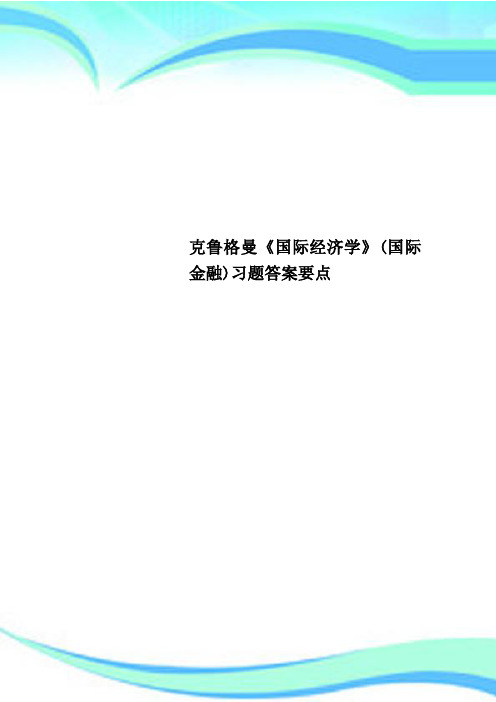
克鲁格曼《国际经济学》(国际金融)习题答案要点————————————————————————————————作者:————————————————————————————————日期:23 《国际经济学》(国际金融)习题答案要点第12章 国民收入核算与国际收支1、如问题所述,GNP 仅仅包括最终产品和服务的价值是为了避免重复计算的问题。
在国民收入账户中,如果进口的中间品价值从GNP 中减去,出口的中间品价值加到GNP 中,重复计算的问题将不会发生。
例如:美国分别销售钢材给日本的丰田公司和美国的通用汽车公司。
其中出售给通用公司的钢材,作为中间品其价值不被计算到美国的GNP 中。
出售给日本丰田公司的钢材,钢材价值通过丰田公司进入日本的GNP ,而最终没有进入美国的国民收入账户。
所以这部分由美国生产要素创造的中间品价值应该从日本的GNP 中减去,并加入美国的GNP 。
2、(1)等式12-2可以写成()()p CA S I T G =-+-。
美国更高的进口壁垒对私人储蓄、投资和政府赤字有比较小或没有影响。
(2)既然强制性的关税和配额对这些变量没有影响,所以贸易壁垒不能减少经常账户赤字。
不同情况对经常账户产生不同的影响。
例如,关税保护能提高被保护行业的投资,从而使经常账户恶化。
(当然,使幼稚产业有一个设备现代化机会的关税保护是合理的。
)同时,当对投资中间品实行关税保护时,由于受保护行业成本的提高可能使该行业投资下降,从而改善经常项目。
一般地,永久性和临时性的关税保护有不同的效果。
这个问题的要点是:政策影响经常账户方式需要进行一般均衡、宏观分析。
3、(1)、购买德国股票反映在美国金融项目的借方。
相应地,当美国人通过他的瑞士银行账户用支票支付时,因为他对瑞士请求权减少,故记入美国金融项目的贷方。
这是美国用一个外国资产交易另外一种外国资产的案例。
(2)、同样,购买德国股票反映在美国金融项目的借方。
当德国销售商将美国支票存入德国银行并且银行将这笔资金贷给德国进口商(此时,记入美国经常项目的贷方)或贷给个人或公司购买美国资产(此时,记入美国金融项目的贷方)。
克鲁格曼 国际经济学第10版 英文答案 国际金融部分krugman_intlecon10_im_14_GE
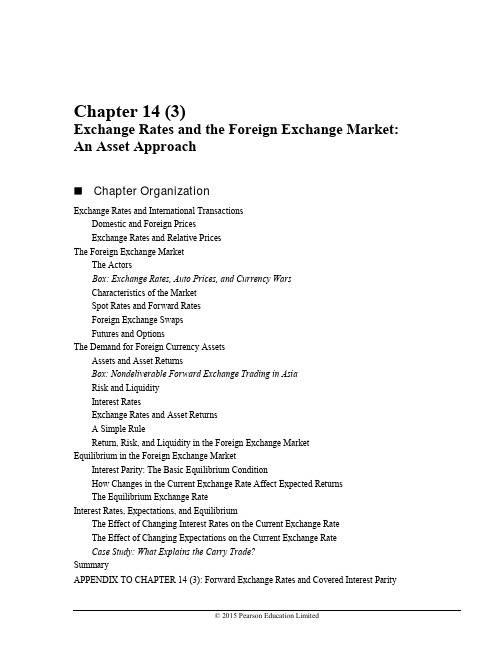
Chapter 14 (3)Exchange Rates and the Foreign Exchange Market: An Asset ApproachChapter OrganizationExchange Rates and International TransactionsDomestic and Foreign PricesExchange Rates and Relative PricesThe Foreign Exchange MarketThe ActorsBox: Exchange Rates, Auto Prices, and Currency WarsCharacteristics of the MarketSpot Rates and Forward RatesForeign Exchange SwapsFutures and OptionsThe Demand for Foreign Currency AssetsAssets and Asset ReturnsBox: Nondeliverable Forward Exchange Trading in AsiaRisk and LiquidityInterest RatesExchange Rates and Asset ReturnsA Simple RuleReturn, Risk, and Liquidity in the Foreign Exchange MarketEquilibrium in the Foreign Exchange MarketInterest Parity: The Basic Equilibrium ConditionHow Changes in the Current Exchange Rate Affect Expected ReturnsThe Equilibrium Exchange RateInterest Rates, Expectations, and EquilibriumThe Effect of Changing Interest Rates on the Current Exchange RateThe Effect of Changing Expectations on the Current Exchange RateCase Study: What Explains the Carry Trade?SummaryAPPENDIX TO CHAPTER 14 (3): Forward Exchange Rates and Covered Interest Parity© 2015 Pearson Education LimitedChapter OverviewThe purpose of this chapter is to show the importance of the exchange rate in translating foreign prices into domestic values as well as to begin the presentation of exchange rate determination. Central to the treatment of exchange rate determination is the insight that exchange rates are determined in the same way a s other asset prices. The chapter begins by describing how the relative prices of different countries’ goods are affected by exchange rate changes. This discussion illustrates the central importance of exchange rates for cross-border economic linkages. The determination of the level of the exchange rate is modeled in the context of the exchange rate’s role as the relative price of foreign and domestic currencies, using the uncovered interest parity relationship.The euro is used often in examples. Some students may not be familiar with the currency or aware of which countries use it; a brief discussion may be warranted. A full treatment of EMU and the theories surrounding currency unification appears in Chapter 20(9).The description of the foreign exchange market stresses the involvement of large organizations (commercial banks, corporations, nonbank financial institutions, and central banks) and the highly integrated natureof the market. The nature of the foreign exchange market ensures that arbitrage occurs quickly so that common rates are offered worldwide. A comparison of the trading volume in foreign exchange markets to that in other markets is useful to underscore how quickly price arbitrage occurs and equilibrium is restored. Forward foreign exchange trading, foreign exchange futures contracts, and foreign exchange options play an important part in currency market activity. The use of these financial instruments to eliminate short-run exchange rate risk is described.The explanation of exchange rate determination in this chapter emphasizes the modern view that exchange rates move to equilibrate asset markets. The foreign exchange demand and supply curves that introduce exchange rate determination in most undergraduate texts are not found here. Instead, there is a discussion of asset pricing and the determination of expected rates of return on assets denominated in different currencies.Students may already be familiar with the distinction between real and nominal returns. The text demonstrates that nominal returns are sufficient for comparing the attractiveness of different assets. There is a brief description of the role played by risk and liquidity in asset demand, but these considerations are not pursued in this chapter. (The role of risk is taken up again in Chapter 18[7].)Substantial space is devoted to the topic of comparing expected returns on assets denominated in domestic and foreign currency. The text identifies two parts of the expected return on a foreign currency asset (measured in domestic currency terms): the interest payment and the change in the value of the foreign currency relative to the domestic currency over the period in which the asset is held. The expected return on a foreign asset is calculated as a function of the current exchange rate for given expected values of the future exchange rate and the foreign interest rate.The absence of risk and liquidity considerations implies that the expected returns on all assets traded in the foreign exchange market must be equal. It is thus a short step from calculations of expected returns on foreign assets to the interest parity condition. The foreign exchange market is shown to be in equilibrium only when the interest parity condition holds. Thus, for given interest rates and given expectations about future exchange rates, interest parity determines the current equilibrium exchange rate. The interest parity diagram introduced here is instrumental in later chapters in which a more general model is presented. Because a command of this interest parity diagram is an important building block for future work, we recommend drills that employ this diagram.The result that a dollar appreciation makes foreign currency assets more attractive may appear counterintuitive to students—why does a stronger dollar reduce the expected return on dollar assets? The key to explaining this point is that, under the static expectations and constant interest rates assumptions, a dollar appreciation today implies a greater future dollar depreciation; so, an American investor can expect to gain not only theChapter 14Exchange Rates and the Foreign Exchange Market: An Asset Approach 77© 2015 Pearson Education Limitedforeign interest payment but also the extra return due to the dollar’s additional future depreciation. The following diagram illustrates this point. In this diagram, the exchange rate at time t + 1 is expected to be equal to E . If the exchange rate at time t is also E , then expected depreciation is 0. If, however, the exchange rate depreciates at time t to E ', then it must appreciate to reach E at time t + 1. If the exchange rate appreciates today to E ", then it must depreciate to reach E at time t + 1. Thus, under static expectations, a depreciation today implies an expected appreciation and vice versa.Figure 14(3)-1This pedagogical tool can be employed to provide some further intuition behind the interest parityrelationship. Suppose that the domestic and foreign interest rates are equal. Interest parity then requires that the expected depreciation is equal to zero and that the exchange rate today and next period is equal to E . If the domestic interest rate rises, people will want to hold more domestic currency deposits. The resulting increased demand for domestic currency drives up the price of domestic currency, causing the exchange rate to appreciate. How long will this continue? The answer is that the appreciation of the domestic currency continues until the expected depreciation that is a consequence of the domestic currency’s appreciation today just offsets the interest differential.The text presents exercises on the effects of changes in interest rates and of changes in expectations of the future exchange rate. These exercises can help develop students’ intuition. For example, the initial result of a rise in U.S. interest rates is a higher demand for dollar-denominated assets and thus an increase in the price of the dollar. This dollar appreciation is large enough that the subsequent expected dollar depreciation just equalizes the expected return on foreign currency assets (measured in dollar terms) and the higher dollar interest rate.The chapter concludes with a case study looking at a situation in which interest rate parity may not hold: the carry trade. In a carry trade, investors borrow money in low-interest currencies and buy high-interest-rate currencies, often earning profits over long periods of time. However, this transaction carries an element of risk as the high-interest-rate currency may experience an abrupt crash in value. The case study discusses a popular carry trade in which investors borrowed low-interest-rate Japanese yen to purchase high-interest-rate Australian dollars. Investors earned high returns until 2008, when the Australian dollar abruptly crashed, losing 40 percent of its value. This was an especially large loss as the crash occurred amidst a financial crisis in which liquidity was highly valued. Thus, when we factor in this additional risk of the carry trade, interest rate parity may still hold.The Appendix describes the covered interest parity relationship and applies it to explain the determination of forward rates under risk neutrality as well as the high correlation between movements in spot and forward rates.Answers to Textbook Problems1. At an exchange rate of 1.05 $ per euro, a 5 euro bratwurst costs 1.05$/euro ⨯ 5 euros = $5.25. Thus,the bratwurst in Munich is $1.25 more expensive than the hot dog in Boston. The relative price is $5.25/$4 = 1.31. A bratwurst costs 1.31 hot dogs. If the dollar depreciates to 1.25$/euro, the bratwurst now costs 1.25$/euro ⨯ 5 euros = $6.25, for a relative price of $6.25/$4 = 1.56. You have to give up1.56 hot dogs to buy a bratwurst. Hot dogs have become relatively cheaper than bratwurst after thedepreciation of the dollar.2. If it were cheaper to buy Israeli shekels with Swiss francs that were purchased with dollars than todirectly buy shekels with dollars, then people would act upon this arbitrage opportunity. The demand for Swiss francs from people who hold dollars would rise, causing the Swiss franc to rise in value against the dollar. The Swiss franc would appreciate against the dollar until the price of a shekel would be exactly the same whether it was purchased directly with dollars or indirectly through Swiss francs.3. Take for example the exchange rate between the Argentine peso, the US dollar, the euro, and theBritish pound. One dollar is worth 5.3015 pesos, while a euro is worth 7.0089 pesos. To rule out triangular arbitrage, we need to see how many pesos you would get if you first bought euros with your dollars (at an exchange rate of 0.7564 euros per dollar), then used these euros to buy pesos. In other words, we need to compute E D = E EUR/USD × E ARG/EUR = 0.7564× 7.0089 = 5.3015 pesos per dollar. This is almost exactly (with rounding) equal to the direct rate of pesos per dollar.Following the same procedure for the British pound yields a similar result.We need to say that triangular arbitrage is “approximately” ruled out for several reasons. First,rounding error means that there may be some small discrepancies between the direct and indirect exchange rates we calculate. Second, transactions costs on trading currencies will prevent complete arbitrage from occurring. That said, the massive volume of currencies traded make these transactions costs relatively small, leading to “near” perfect arbitrage.4. A depreciation of Chinese yuan makes the import more expensive. Since the demand for oil isinelastic, China needs to import oil from the oil exporting countries. This leads to spending more on oil when the exchange rate falls in value. This can cause the balance of payment to worsen in the short run. Hence, a depreciation of domestic currency may or may not have a favourable impact on the balance of payment in the short run.5. The dollar rates of return are as follows:a. ($250,000 - $200,000)/$200,000 = 0.25.b. ($275 - $255)/$255 = 0.08.c. There are two parts to this return. One is the loss involved due to the appreciation of the dollar;the dollar appreciation is ($1.38 - $1.50)/$1.50 =-0.08. The other part of the return is the interest paid by the London bank on the deposit, 10 percent. (The size of the deposit is immaterial to thecalculation of the rate of return.) In terms of dollars, the realized return on the London depositis thus 2 percent per year.。
克鲁格曼《国际经济学》(国际金融部分)课后习题答案(英文版)第一章

CHAPTER 1INTRODUCTIONChapter OrganizationWhat is International Economics About?The Gains from TradeThe Pattern of TradeProtectionismThe Balance of PaymentsExchange-Rate DeterminationInternational Policy CoordinationThe International Capital MarketInternational Economics: Trade and MoneyCHAPTER OVERVIEWThe intent of this chapter is to provide both an overview of the subject matter of international economics and to provide a guide to the organization of the text. It is relatively easy for an instructor to motivate the study of international trade and finance. The front pages of newspapers, the covers of magazines, and the lead reports of television news broadcasts herald the interdependence of the U.S. economy with the rest of the world. This interdependence may also be recognized by students through their purchases of imports of all sorts of goods, their personal observations of the effects of dislocations due to international competition, and their experience through travel abroad.The study of the theory of international economics generates an understanding of many key events that shape our domestic and international environment. In recent history, these events include the causes and consequences of the large current account deficits of the United States; the dramatic appreciation of the dollar during the first half of the 1980s followed by its rapid depreciation in the second half of the 1980s; the Latin American debt crisis of the 1980s and the Mexico crisis in late 1994; and the increased pressures for industry protection against foreign competition broadly voiced in the late 1980s and more vocally espoused in the first half of the 1990s. Most recently, the financial crisis that began in East Asia in 1997 andspread to many countries around the globe and the Economic and Monetary Union in Europe have highlighted the way in which various national economies are linked and how important it is for us to understand these connections. At the same time, protests at global economic meetings have highlighted opposition to globalization. The text material will enable students to understand the economic context in which such events occur.Chapter 1 of the text presents data demonstrating the growth in trade and increasing importance of international economics. This chapter also highlights and briefly discusses seven themes which arise throughout the book. These themes include: 1) the gains from trade;2) the pattern of trade; 3) protectionism; 4), the balance of payments; 5) exchange rate determination; 6) international policy coordination; and 7) the international capital market. Students will recognize that many of the central policy debates occurring today come under the rubric of one of these themes. Indeed, it is often a fruitful heuristic to use current events to illustrate the force of the key themes and arguments which are presented throughout the text.。
国际经济学阶段性练习(2)答案
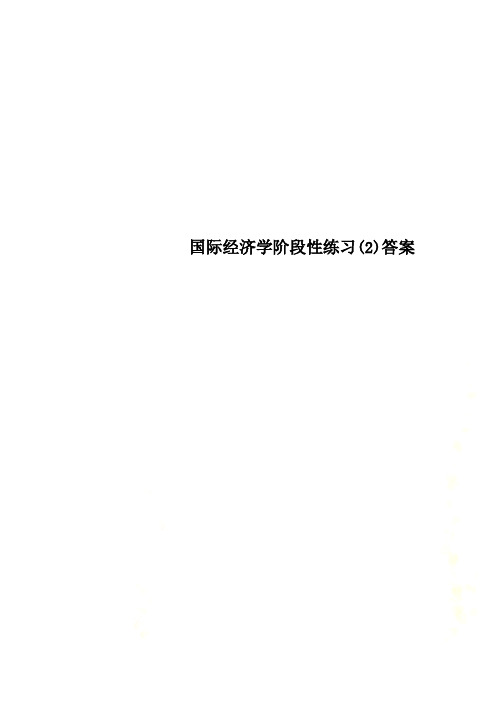
国际经济学阶段性练习(2)答案第二阶段(国际金融部分:第5-9章)一、单项选择题(每题1分,共10分)1、有形的外汇市场又称为B外汇市场。
A.美国式B.欧洲大陆式C.日本式D.西方式2、我们现在所常说的《巴塞尔协议》是指B 。
A.《对银行国外机构的监管原则》B.《关于统一国际银行资本衡量和资本标准的协议》C.《银行业有效监管核心原则》D.《资本计量和资本标准的国际协议:修订框架》3、有关汇率决定最早的理论说明是A。
A.铸币平价理论B.购买力平价理论C.货币主义汇率理论D.资本选择平衡理论4、英国经济学家B首先提出输金点的存在也就是国际收支的自动调节机制。
A.李斯特B.休谟C.卡塞尔D.维克塞尔5、“一价定律”是A所采用的汇率决定原则。
A.绝对的购买力平价B.相对的购买力平价C.货币主义汇率理论D.资本选择平衡理论6、国际储备的需求管理,主要涉及两方面内容:一是数量管理;二是B。
A.规模管理B.结构管理C.总量管理D.币值管理7、下列几项中不属于政策引导机制中直接管制政策的是D。
A.关税壁垒B.非关税壁垒C.出口鼓励政策D.货币政策8、政府对外公布法定的平价和允许汇率上下波动的幅度,但可以定期调整法定的平价,以利用货币贬值来校正国际收支不平衡,这种汇率制度为A。
A.可调整的盯住汇率B.爬行盯住汇率C.有管理的浮动汇率D.浮动汇率9、布雷顿森林体系建立于C。
A.1914年B.1918年C.1944年D.1971年10、B首先承认浮动汇率制存在的合理性。
A.洛美协定B.牙买加协议C.史密森协议D.布雷顿森林体系二、多项选择题(每题2分,共20分)1、以下描述外汇市场的功能,正确的有BCDE。
A.仅仅发挥外汇买卖、调节余缺的作用B.提供了全球融资的场所C.为各国进行汇率的联合干预提供了场所D.为回避外汇风险和进行外汇投机提供了场所E.绝大多数外汇交易属于投机营利活动2、根据来源与用途的不同,外汇可分为ABC。
《国际经济学》课程标准
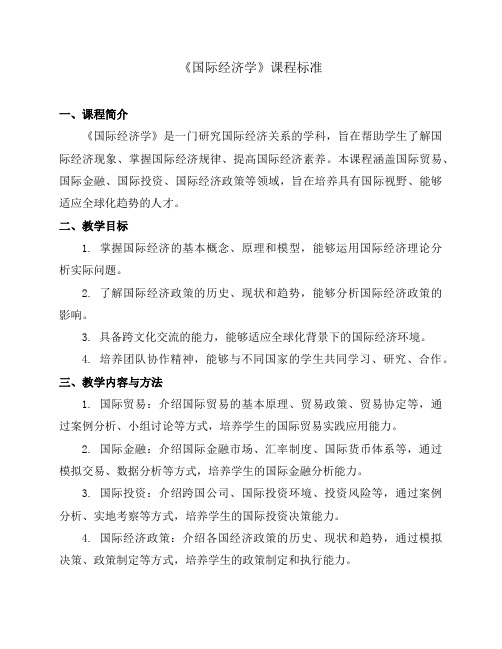
《国际经济学》课程标准一、课程简介《国际经济学》是一门研究国际经济关系的学科,旨在帮助学生了解国际经济现象、掌握国际经济规律、提高国际经济素养。
本课程涵盖国际贸易、国际金融、国际投资、国际经济政策等领域,旨在培养具有国际视野、能够适应全球化趋势的人才。
二、教学目标1. 掌握国际经济的基本概念、原理和模型,能够运用国际经济理论分析实际问题。
2. 了解国际经济政策的历史、现状和趋势,能够分析国际经济政策的影响。
3. 具备跨文化交流的能力,能够适应全球化背景下的国际经济环境。
4. 培养团队协作精神,能够与不同国家的学生共同学习、研究、合作。
三、教学内容与方法1. 国际贸易:介绍国际贸易的基本原理、贸易政策、贸易协定等,通过案例分析、小组讨论等方式,培养学生的国际贸易实践应用能力。
2. 国际金融:介绍国际金融市场、汇率制度、国际货币体系等,通过模拟交易、数据分析等方式,培养学生的国际金融分析能力。
3. 国际投资:介绍跨国公司、国际投资环境、投资风险等,通过案例分析、实地考察等方式,培养学生的国际投资决策能力。
4. 国际经济政策:介绍各国经济政策的历史、现状和趋势,通过模拟决策、政策制定等方式,培养学生的政策制定和执行能力。
教学方法:课堂讲授、案例分析、小组讨论、模拟实践、实地考察等。
四、课程评估1. 平时成绩评估:通过课堂表现、作业完成情况、小组讨论参与度等方式,评估学生的平时表现。
2. 期末考试:通过闭卷考试方式,考查学生对国际经济学基本原理、模型等的掌握情况。
3. 实践成果:学生提交实践报告或研究论文等成果,作为课程评估的重要参考。
五、课程资源1. 教材:《国际经济学》教材及相关参考书籍。
2. 网络资源:国内外相关学术网站、论坛、社交媒体等,提供学生了解国际经济动态和前沿研究成果的平台。
3. 实践教学基地:与跨国企业、金融机构等建立合作关系,为学生提供实地考察和实习的机会。
4. 师资队伍:具备丰富教学经验和学术背景的教师团队,为学生提供高质量的教学服务。
国际金融学完整
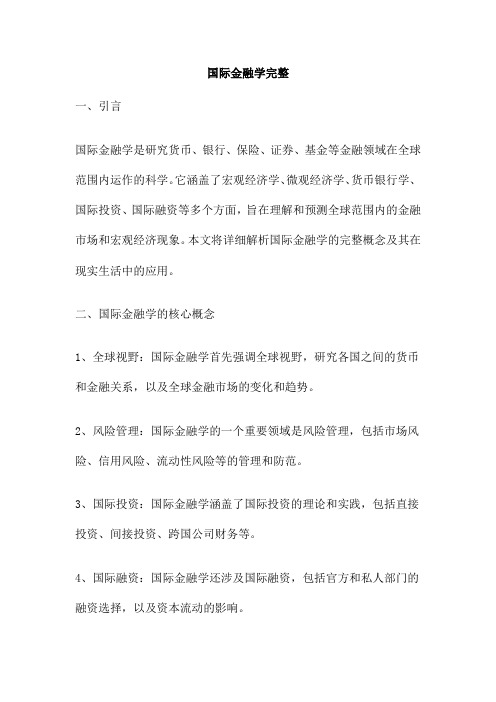
国际金融学完整一、引言国际金融学是研究货币、银行、保险、证券、基金等金融领域在全球范围内运作的科学。
它涵盖了宏观经济学、微观经济学、货币银行学、国际投资、国际融资等多个方面,旨在理解和预测全球范围内的金融市场和宏观经济现象。
本文将详细解析国际金融学的完整概念及其在现实生活中的应用。
二、国际金融学的核心概念1、全球视野:国际金融学首先强调全球视野,研究各国之间的货币和金融关系,以及全球金融市场的变化和趋势。
2、风险管理:国际金融学的一个重要领域是风险管理,包括市场风险、信用风险、流动性风险等的管理和防范。
3、国际投资:国际金融学涵盖了国际投资的理论和实践,包括直接投资、间接投资、跨国公司财务等。
4、国际融资:国际金融学还涉及国际融资,包括官方和私人部门的融资选择,以及资本流动的影响。
5、政策协调:国际金融学也政策协调,如货币政策、财政政策、汇率政策等在国际环境下的影响和协调。
三、国际金融学的应用1、跨国公司:跨国公司在全球范围内进行投资和经营,需要理解和应对各种货币风险和金融市场风险。
2、金融机构:全球的金融机构都需要理解和适应不断变化的金融市场环境,以及不断出现的风险。
3、政府决策:各国政府在制定货币政策、财政政策、汇率政策时,需要考虑到全球金融市场的环境和影响。
4、个人理财:个人在规划自己的财务时,也需要考虑到全球的金融市场情况和自身的风险承受能力。
四、结论国际金融学是一门涵盖了众多领域的综合性学科,它不仅全球范围内的金融市场运作,也由此产生的宏观经济影响。
它为我们理解和应对全球范围内的金融市场提供了理论支持和实践指导。
无论是跨国公司、金融机构、政府决策者还是个人理财者,理解和应用国际金融学的原理都对其决策和规划具有重要意义。
在国际金融学中,以下哪个选项对货币的理解最准确?B. World Bank主要负责国际投资国际金融学是研究国际间货币和金融现象的一门学科,它涉及到货币、汇率、国际货币体系、国际金融市场、国际金融机构等多方面内容。
国际经济学的主要内容

国际经济学的主要内容国际经济学是研究国际贸易、国际金融以及国际经济合作与竞争等问题的学科。
它是经济学的一个重要分支,主要内容包括国际贸易理论、国际货币理论、国际经济政策和国际经济组织等方面。
首先,国际经济学的主要内容之一是国际贸易理论。
国际贸易理论主要研究国际贸易的原因、模式和效果。
比较优势理论、绝对优势理论、要素比较理论、新贸易理论等都是国际贸易理论的重要内容。
比较优势理论和绝对优势理论是古典贸易理论的代表,它们解释了国际贸易的原因和模式。
而要素比较理论和新贸易理论则更多地从生产要素的角度解释国际贸易的模式和效果。
其次,国际经济学的主要内容还包括国际货币理论。
国际货币理论主要研究国际货币体系、国际支付和汇率等问题。
金本位制、固定汇率制、浮动汇率制等都是国际货币理论的重要内容。
国际货币理论不仅关注国际货币体系的演变和效果,还关注国际支付和汇率的稳定性和变动性。
此外,国际经济学的主要内容还涉及国际经济政策。
国际经济政策主要研究国际贸易政策、国际金融政策和国际产业政策等问题。
关税、配额、补贴等都是国际贸易政策的重要工具,而汇率政策、资本流动限制等则是国际金融政策的重要内容。
国际经济政策的目的是促进国际贸易和国际金融的自由化和便利化,同时保护国内产业和就业。
最后,国际经济学的主要内容还包括国际经济组织。
国际货币基金组织、世界银行、世界贸易组织等国际经济组织是国际经济合作与竞争的重要平台,它们主要负责监督和管理国际货币体系、国际贸易体系和国际金融体系,促进国际经济的稳定和发展。
总之,国际经济学的主要内容涵盖国际贸易理论、国际货币理论、国际经济政策和国际经济组织等方面。
通过对这些内容的研究,我们可以更好地理解和应对国际经济领域的挑战和机遇,促进国际经济的稳定和繁荣。
克鲁格曼《国际经济学》(国际金融)习题答案要点

《国际经济学》(国际金融)习题答案要点第12章 国民收入核算与国际收支1、如问题所述,GNP 仅仅包括最终产品和服务的价值是为了避免重复计算的问题。
在国民收入账户中,如果进口的中间品价值从GNP 中减去,出口的中间品价值加到GNP 中,重复计算的问题将不会发生。
例如:美国分别销售钢材给日本的丰田公司和美国的通用汽车公司。
其中出售给通用公司的钢材,作为中间品其价值不被计算到美国的GNP 中。
出售给日本丰田公司的钢材,钢材价值通过丰田公司进入日本的GNP ,而最终没有进入美国的国民收入账户。
所以这部分由美国生产要素创造的中间品价值应该从日本的GNP 中减去,并加入美国的GNP 。
2、(1)等式12-2可以写成()()p CA S I T G =-+-。
美国更高的进口壁垒对私人储蓄、投资和政府赤字有比较小或没有影响。
(2)既然强制性的关税和配额对这些变量没有影响,所以贸易壁垒不能减少经常账户赤字。
不同情况对经常账户产生不同的影响。
例如,关税保护能提高被保护行业的投资,从而使经常账户恶化。
(当然,使幼稚产业有一个设备现代化机会的关税保护是合理的。
)同时,当对投资中间品实行关税保护时,由于受保护行业成本的提高可能使该行业投资下降,从而改善经常项目。
一般地,永久性和临时性的关税保护有不同的效果。
这个问题的要点是:政策影响经常账户方式需要进行一般均衡、宏观分析。
3、(1)、购买德国股票反映在美国金融项目的借方。
相应地,当美国人通过他的瑞士银行账户用支票支付时,因为他对瑞士请求权减少,故记入美国金融项目的贷方。
这是美国用一个外国资产交易另外一种外国资产的案例。
(2)、同样,购买德国股票反映在美国金融项目的借方。
当德国销售商将美国支票存入德国银行并且银行将这笔资金贷给德国进口商(此时,记入美国经常项目的贷方)或贷给个人或公司购买美国资产(此时,记入美国金融项目的贷方)。
最后,银行采取的各项行为将导致记入美国国际收支表的贷方。
丹尼斯国际经济学国际金融分册课后习题
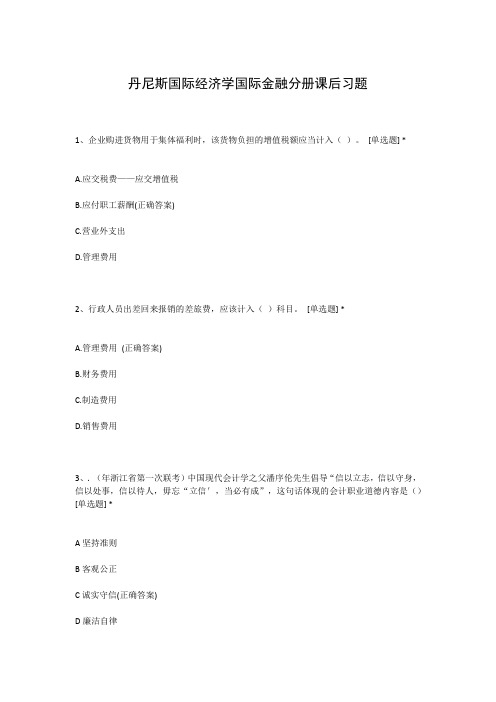
丹尼斯国际经济学国际金融分册课后习题1、企业购进货物用于集体福利时,该货物负担的增值税额应当计入()。
[单选题] *A.应交税费——应交增值税B.应付职工薪酬(正确答案)C.营业外支出D.管理费用2、行政人员出差回来报销的差旅费,应该计入()科目。
[单选题] *A.管理费用(正确答案)B.财务费用C.制造费用D.销售费用3、.(年浙江省第一次联考)中国现代会计学之父潘序伦先生倡导“信以立志,信以守身,信以处事,信以待人,毋忘“立信',当必有成”,这句话体现的会计职业道德内容是()[单选题] *A坚持准则B客观公正C诚实守信(正确答案)D廉洁自律4、当法定盈余公积达到注册资本的()时,可以不再提取。
[单选题] *A.10%B.20%C.50%(正确答案)D.30%5、.(年浙江省第二次联考)会计人员的职业道德规范不包括()[单选题] *A操守为重、不做假账(正确答案)B爱岗敬业、诚实守信C、廉洁自律、客观公正D坚持准则、提高技能6、企业用盈余公积转增资本时,转增后留存的盈余公积的数额不得少于转增前注册资本()。
[单选题] *A.20%B.15%C.25%(正确答案)D.50%7、商标权有法定有效期限,一般商标权的有效期限为()。
[单选题] *A.5年B.10年(正确答案)C.15年D.20年8、计提固定资产折旧时,可以先不考虑固定资产残值的方法是()。
[单选题] *A.年限平均法B.工作量法C.双倍余额递减法(正确答案)D.年数总和法9、.(年浙江省第三次联考)下列不属于企业事前核算主要形式的是()[单选题] * A进行预测B参与计划C、进行控制(正确答案)D参与决策10、下列交易和事项中,不应确认为营业外支出的是()。
[单选题] *A.对外捐赠支出B.债务重组损失C.计提的存货跌价准备(正确答案)D.处置报废固定资产损失11、股份有限公司为核算投资者投入的资本应当设置()科目。
[单选题] *A.“实收资本”B.“股东权益”C.“股本”(正确答案)D.“所有者权益”12、委托加工应纳消费税产品(非金银首饰)收回后,如直接对外销售,其由受托方代扣代交的消费税,应计入()。
国际金融名词解释,简答,论述

马歇尔-勒纳条件:如果一国处于贸易逆差中,会引起本币贬值,本币贬值会改善贸易逆差,但需要的具体条件是进出口需求弹性之和大于1,即(Dx+Di)>1外汇:狭义的外汇是指以外币表示的用于国际债权债务结算的支付手段。
间接标价法:用1个单位或100个单位的本国货币作为基准折算成一定数额的外国货币J型曲线效应:在现实中,货币贬值导致贸易差额的最终改善需要一个“收效期”,收效快慢取决于供求反应程度高低,并且在汇率变化的收效期内会出现短期的国际收支恶化现象。
这种现象用曲线表现成丁字形。
自由兑换货币:指该货币是国际交易中被广泛使用的支付货币;该货币是主要外汇市场上普遍进行交易(买卖)的货币。
离岸金融市场:是指主要为非居民提供境外货币借贷或投资,贸易结算,外汇黄金买卖,保险服务及证券交易等金融业务和服务的一种国际金融市场。
IBF:是指国际银行设施,是在美国境内的美国银行或外国银行开立的经营欧洲货币和欧洲美元的账户,此体系资产独立于总财产分开。
欧洲货币市场:在一国境外进行该国货币借贷的国际市场。
票据发行便利:票据发行便利是银行与借款人之间签定的在未来的一段时间内由银行以承购连续性短期票据的形式向借款人提供信贷资金的协议,协议具有法律约束力。
远期利率协定:指交易双方在未来的结算日,针对某一特定主义本金,参照贴现原则,就协议利率与参考利率差额进行支付的远期合作。
择期:是指远期外汇的购买者(或出卖者)在合约的有效期内任何一天,有权要求银行实行交割的一种业务。
交易风险:经营活动中的风险,也称转换风险,主要指由于汇率变化而引起资产负债表中某些外汇项目金额变动的风险。
折算风险:又称会计风险。
是指是经营活动中的风险,主要指由于汇率变化而引起资产负债表中某些外汇项目金额变动的风险。
经济风险:又称经营风险,是预期经营收益的风险,只有与外汇汇率发生波动而引起国际企业未来收益变化的一种潜在的风险。
购买力评价说:两国货币的汇率主要是有两国货币的购买力决定的。
什么是国际经济学

•
•
•
•
•
国际贸易理论的发展(2)
• 新贸易理论的出现有两大渊源: • 产业内贸易(Intra-industry Trade),即发生在同一产业类别中的双 向贸易(Two-way Trade),已成为主流。格鲁珀(H.G.Grubel)和 劳埃德(P.J.Lloyd)在1975年还构造了一种测量产业内贸易密集度的 指数方法,用于测算国际贸易中产业内贸易的重要性。G—L产业内贸 易指数,与B.Balassa提出的产业内贸易指数略有不同。 • 产业组织理论的发展。20世纪70年代中期,产业组织理论出现了一次 大的突破,特别是博弈论方法被引入到产业组织理论的研究中之后,对 不完全竞争市场结构下(主要是针对寡头市场)厂商行为的描述与研究, 取得了巨大的成功。1978年,克鲁格曼在其博士论文《收益递增、垄 断竞争与国际贸易》(Increasing Returns, Monopolistic Competition, and International Trade)中,首次将迪克西特(A.Dixit)和斯蒂格利 茨(J.Stiglitz)两人所共同提出的将差异产品和(内部)规模经济考虑 在内的垄断竞争模型(该模型又称“新张伯伦模型”)推广到开放经济 条件下,从模型上首次证明了规模经济是国际贸易的另一起因,以及差 异性产品决定了贸易形态为产业内贸易。 • 新贸易理论除了都强调规模经济的作用这一共同点外,并未形成统一的 分析框架。
国际经济学研究的主要内容
• • 国际经济学研究的主要内容可以区分为实物经济(Real Economy)方面和货币 经济(Monetary Economy)方面两个部分。 1.国际经济学研究的实物经济方面,也称国际微观经济学(International Microeconomics)或国际贸易(International Trade),它主要研究国际贸易和 国际要素流动,包括影响国际贸易和国际要素流动的主要因素,贸易和要素流 动对资源配置和收入分配以及福利的影响,国家经济政策对贸易和要素流动的 影响等。 国际经济学的国际贸易部分通常包括国际贸易理论(Trade Theory)和贸易政 策(Trade Policy)两个部分,是国际经济学的微观部分。它以单个国家为基本 分析单位,研究单个商品的相对价格及其决定,这与微观经济学非常相似。国 际贸易理论分析贸易的基础(The Basis for Trade)、贸易的模式(The Patterns of Trade)以及贸易的利益(The Gains from Trade)。国际贸易政策 考察贸易限制的措施及其影响,贸易保护的原因和效果。 2.国际经济学研究的货币经济方面,也称国际宏观经济学(International Macroeconomics)或国际金融(Internationce of Payments)及其调整过程,包括外汇市场和汇率决定,国际收 支及其在不同汇率制度下的调整过程等。 国际经济学的国际金融部分则包括汇率和外汇市场,国际收支及其调整等内容。 它涉及货币和总收支,收入水平和价格指数等宏观经济变量,这与宏观经济学 非常相似。外汇市场探讨一国货币与它国货币相交换的框架及汇率的决定;国 际收支用以测度一国与外部世界交易的总收入和总支出及其平衡;国际收支调 整研究在不同汇率和国际货币制度下,一国国际收支失衡调整过程及其对国内 经济的影响。
国际经济学国际金融知识点

国际经济学国际金融知识点一、知识概述《汇率》①基本定义:汇率呢,就好比是一种价格,是一个国家的货币兑换另一个国家货币的比率。
比如说,1美元能换7元人民币,这个7就是美元兑人民币的汇率。
②重要程度:在国际金融里那可是相当重要的。
它直接影响着国际贸易、国际投资这些大事。
如果汇率变了,进出口企业的成本和利润就会跟着变,外国投资者想投资的时候也得看看汇率划不划算。
③前置知识:得先对货币有点概念,知道不同国家有不同的货币体系,同时要了解一点宏观经济基础知识,像国内生产总值之类的,因为汇率和国家的经济状况是有关系的。
④应用价值:对于做进出口生意的企业来说,汇率变动就决定了他们的成本和收益。
我有个亲戚是做外贸的,汇率涨一点或者跌一点,利润就差很多。
旅游的时候也能用到,去国外旅游花的钱就和汇率挂钩。
二、知识体系①知识图谱:汇率处于国际金融知识体系的核心位置,很多国际收支、国际资本流动等问题都与汇率密切相关。
就像蜘蛛网的中心,其他知识点都围绕着它有一定的联系。
②关联知识:和国际贸易收支有关,如果一个国家出口老是比进口多,这个国家的货币可能就会升值。
还有国际资本流动,如果一个国家利率高,吸引了很多外国投资,那这个国家货币的需求就大,汇率可能就上升。
③重难点分析:- 掌握难度:难。
因为汇率受到很多因素的影响,像经济政策、国际局势、市场预期等,这些因素还会相互作用。
- 关键点:要抓住影响汇率的主要因素,比如通货膨胀率的差异,经济增长的快慢。
说实话,有时候这些因素缠在一块儿,有点让人头疼。
④考点分析:- 在考试中的重要性:超级重要,是国际金融的必考内容。
- 考查方式:可能出简答题问汇率的影响因素;可能出计算题,让你根据给定的经济数据计算汇率的变化;也可能在论述题里,让你分析汇率变化对一个国家宏观经济的影响。
三、详细讲解【理论概念类】①概念辨析:汇率就是不同货币之间兑换的比率,有名义汇率、实际汇率这些区分。
名义汇率就是市场上看到的汇率,而实际汇率是考虑了物价因素之后的汇率。
国际经济学的国际金融部分的选择题练习

C h a p t e r13:T h e B a l a n c e o f P a y m e n t sMultiple-choice Questions:1. Which of the following is false?A. A credit transaction leads to a payment from foreignersB. A debit transaction leads to a payment to foreigners*C. A credit transaction is entered with a negative signD. Double-entry bookkeeping refers to each transaction entered twice.2. Which of the following is a debit?A. The export of goodssterling balances in a London Bank, the U.S. debits its current account and credits its:A. official reserve accountB. unilateral transfers accountC. services in its current account*D. capital account8. When the U.S. ships food aid to a developing nation, the U.S. debits:*A. unilateral transfersB. servicesC. capitalD. official reserves9. When the resident of a foreign nation (1) sells a U.S. stock and (2) deposits the proceeds in a U.S. bank, the U.S.:A. credits capital for (1) and debits capital for (2)B. credits the current account and debits capitalC. debits capital and credits official reserves*D. debits capital for (1) and credits capital for (2)10. When a U.S. resident (1) purchases foreign treasury bills and pays by (2) drawing down his bank balances abroad,the U.S.:A. debits short-term capital and credits official reserves*B. debits capital for (1) and credits capital for (2)C. debits official reserves and credits capitalD. credits short-term capital and debits official reservesD. a net debit balance in the official reserve account refers to a surplus思考题:以2009年中美两国国际收支平衡表为例,分析两国国际经济交易呈现出哪些不同特征?战后美国出现大的贸易失衡,其原因和影响是什么?中国的外汇储备量世界第一,其原因是?有何利弊?Chapter 14: Foreign Exchange Markets and Exchange RatesMultiple-choice Questions:1. Which is not a function of the foreign exchange market?A. to transfer funds from one nation to anotherB. to finance trade*C. to diversify risksD. to provide the facilities for hedging2. An increase in the pound price of the dollar represents:*A. an appreciation of the dollarB. a depreciation of the dollarC. an appreciation of the poundD. a devaluation of the dollar3. A change from $1=€1 to $2=€1 represents*A. depreciation of the dollarB. an appreciation of the dollar*B. the covering of a foreign exchange riskC. foreign exchange speculationD. foreign exchange arbitrage9. A U.S. importer scheduled to make a payment of €100,000 in three months can hedgehis foreign exchange risk by:A. purchasing $100,000 in the forward market for delivery in three monthsB. selling €100,000 in the spot market for delivery in three months*C. purchasing €100,000 in the forward market for delivery in three monthsD. selling €100,000 in the spot market for delivery in three months10. If the three-month FR=$1/€1 and a speculator anticipates that SR=$1.02/€1 in threemonths, he can earn a profit by:A. selling euros forward*B. purchasing euros forwardC. selling dollars forwardD. purchasing dollars forward11. Destabilizing speculation refers to the:*A. sale of the foreign currency when the exchange rate falls or is lowB. purchase of the foreign currency when the exchange rate falls or is lowC. sale of the foreign currency when the exchange rate rises or is highD. all of the above12. A capital outflow from New York to Frankfurt under covered interest arbitrage can take place if the interest3. 如何看待以美国为首的国家要求人民币升值问题?4. 如何看待人民币国际化的前景?Chapter 15: Exchange Rate DeterminationMultiple-choice Questions:1. Which is correct with respect to the absolute PPP theory?A. It postulates that the exchange rate between two currencies is equal to the ratio of the price levels in the two nationsB. it does not take into consideration transportation costs or other obstructions to the flow of international tradeC. can be very misleading*D. all of the above2. The relative purchasing power-parity theory postulates that:A. The equilibrium exchange rate is equal to the ratio of the price level in the two nations*B. the change in the exchange rate over a period of time should be proportional to the relative change in the pricelevel in the two nations over the same time periodC. the change in the exchange rate over a period of time should be proportional to the absolute change in the pricelevel in the two nations over the same time periodD. the exchange rate at a period of time should be proportional to the relative prices in the two nations3. The relative PPP theory gives better results:*A. in the long run than in the short runB. when structural changes take placeC. the greater is the level of commodity aggregation8. According to the monetary approach to the balance of payments, a deficit in the nation's balance of payments resultsfrom:*A. an excess in the nation's stock of money supply that is not eliminated or corrected by the nation's monetaryauthoritiesB. an excess in the stock of money demanded in the nation that is not satisfied by domestic monetary authoritiesC. an excess in the stock of money demanded in the other nation that is not satisfied by the other nation's monetaryauthoritiesD. an excess of imports over exports in the nation9. If the increase in a nation's money supply grows less rapidly than its GNP, the nation will face a:A. once-and-for-all balance of payments deficitB. once-and-for-all balance of payments surplusC. continuous balance of payments deficit*D. continuous balance of payments surplus10. According to the monetary approach to the balance of payments a non-reserve currency nation:*A. has no control over its money supply in the long-run under fixed exchange ratesB. has no control over its money supply in the short-run under fixed exchange ratesC. has no control over its money supply in the long-run under flexible exchange ratesD. retains complete control over its money supply in the long-run11. According to the monetary approach to the balance of payments, a surplus nation will have to give up in the long-runits goal of:A. price stabilityresidents to increase the demand for the:A. domestic moneyB. domestic bond*C. foreign bondD. all of the above17. According to the portfolio balance approach, an increase in domestic real income or GDP leads domestic residents toincrease the demand for the:*A. domestic moneyB. domestic bondC. foreign bondD. all of the above18. According to the portfolio balance approach, an increase in domestic wealth leads domestic residents to increase thedemand for the:A. domestic moneyB. domestic bondC. foreign bond*D. all of the above19. Which of the following is false with regard to exchange rate dynamics:A. seeks to explain exchange rate fluctuations over time*B. results because the real sector adjusts instantaneously to disturbancesC. in the short run, the exchange rate overshoots its long-run equilibrium*B. smaller is the devaluation or depreciation required to correct a deficit of a given size in the nation's balance ofpaymentsC. less feasible is a flexible exchange rate systemD. less feasible is a devaluation as a policy to correct a deficit in the nation's balance of payments2. A nation's demand curve for foreign exchange is derived from the:A. foreign demand curve for the nations' exportsB. nation's supply curve of exports*C. domestic demand curve for imports and the foreign supply curve for the nation's importsD. foreign demand curve and the domestic supply curve for the nation's exports3. A depreciation of a nation's currency shifts:A. down its supply curve of imports in terms of the foreign currencyB. up its demand curve of imports in terms of the foreign currency*C. down its demand curve of imports in terms of the foreign currencyD. down its demand curve of imports in terms of the domestic currency4. When a nation's demand curve for imports in terms of the foreign currency is vertical:*A. the nation's demand curve for the foreign currency has zero elasticityB. the nation's demand for the currency is elasticC. the nation's supply of the currency is verticalD. the other nation's demand for the nation's currency has zero elasticity5. A depreciation of a nation's currency shifts:A. down its supply curve of exports in terms of the domestic currencypositively inclinedB. the supply curve of foreign exchange is negatively inclined and less elastic than the demand curveC. the sum of the absolute values of the elasticity of the nation's demand of imports and the foreign demand for thenation's exports is greater than one*D. all of the above11. The United States has a trade problem with Japan because the U.S. trade deficit with Japan:A. is very largeB. has persisted for a long timeC. did not seem to decline when the dollar depreciated sharply with respect to the yen*D. all of the above12. The mint parity refers to the:A. gold export pointB. gold import pointC. equilibrium exchange rate*D. ratio of the price of a unit of gold in terms of the currency of two nations13. Under the gold standard:A. each nations defines the price of gold in terms of its currency and then stands ready to buy and sell any amount ofgold at that priceB. there is a fixed relationship between any two currencies called the mint parityC. the exchange rate is determined by demand and supply between the gold points and is prevented from movingoutside the gold points by gold shipmentsB. all prices, wages, and interest rates are constantC. the nation operates at less than full employment*D. all of the above2. The marginal propensity to consume measures:A. the ratio of imports to incomeB. the ratio of income to imports*C. the change in imports over the change in incomeD. the change in income over the change in imports3. The income elasticity of imports is given by:A. the percentage change in income over the percentage change in importsB. the change in imports over the change in income*C. the marginal propensity to import over the average propensity to importD. the average propensity to import over the marginal propensity to import4. The equilibrium level of national income in an open economy is given by:A. I + X = S + MB. X - M = S - IC. I + (X-M) = S*D. all of the above5. If MPS=0.2 and MPM=0.3, the foreign trade multiplier is:A. 5B. 3.3C. 3B. with foreign repercussions for an autonomous increase in nation 1's X that replace domestic production in nation 2*C. with foreign repercussions for an autonomous increase in I in nation 1D. with foreign repercussions for an autonomous increase in I in nation 211. By itself, the automatic income adjustment mechanism is likely to bring about:*A. incomplete adjustmentB. complete adjustmentC. perverse adjustmentD. any of the above12. A depreciation of a deficit nation's currency from a condition of full employment:*A. may improve the nation's trade balanceB. will improve the nation's trade balanceC. will leave the nation's trade balance unchangedD. will cause a deterioration in the nation's trade balance13. The improvement in a nation's balance of trade and payments resulting from a depreciationof its currency is:A. reinforced by the induced fall in imports*B. partly neutralized by the induced rise in importsC. partly neutralized by the induced fall in importsD. any of the above.14. In the real world, the automatic income, price, and interest adjustment mechanisms, ifallowed to operate, are likely to:D. an equitable distribution of income2. In order to achieve internal and external balance simultaneously, a nation must usually use at least:A. one policy*B. two policiesC. three policiesD. cannot say3. Points below internal balance line YY in the Swan diagram indicate:A. a balance of payments deficitB. a balance of payments surplus*C. unemploymentD. inflation4. To correct a balance of payments deficit and unemployment a nation requires a:A. devaluation and expansionary fiscal and monetary policiesB. devaluation and contractionary fiscal and monetary policies*C. devaluation and either expansionary or contractionary fiscal and monetary policiesD. revaluation and either expansionary or contractionary fiscal and monetary policies5. To correct a balance of payments deficit and inflation a nation requires a:A. devaluation and expansionary fiscal and monetary policiesB. devaluation and contractionary fiscal and monetary policies*C. devaluation or revaluation and contractionary fiscal and monetary policiesD. revaluation and either expansionary or contractionary fiscal and monetary policies6. To correct a balance of payments surplus and unemployment a nation requires a:full employment level of national income the nation's BP curve is:*A. above the LM curveB. below the LM curveC. steeper than the LM curveD. above the IS curve12. In a world of perfectly elastic international capital flows and fixed exchange rates:A. fiscal policy is completely ineffective*B. monetary policy is completely ineffectiveC. both fiscal and monetary policies are completely ineffectiveD. both fiscal and monetary policies are effective13. To correct unemployment and a balance of payments deficits with flexible exchange rates and imperfect capitalmobility:A. both fiscal and monetary policies are requiredB. fiscal policy is requiredC. monetary policy is required*D. either monetary or fiscal policy is required14. To correct a balance of payments surplus and inflation a nation requires:A. expansionary fiscal policy and easy monetary policyB. contractionary fiscal policy and tight monetary policy*C. contractionary fiscal policy and easy monetary policyD. expansionary fiscal policy and tight monetary fiscal policy根据IB曲线和使D. all of the above2. The aggregate demand curve (AD) for closed economy is derived from theA. IS curveB. LM curveC. FE curve*D. IS and LM curves3. A reduction in the general price level with a constant money supply is shown by aA. leftward shift in the LM curve*B. movement down along a given aggregate demand curveC. rightward shift in the aggregate supply curveD. a rightward shift in the IS curve4. An increase in the money supply with constant prices leads to aA. leftward shift in the LM curveB. movement along a given aggregate demand curve*C. rightward shift in the aggregate demand curveD. rightward shift in the IS curve5. An increase in government expenditures leads toA. a rightward shift in the IS curveB. a rightward shift in the AD curveC. an increase in the level of national income*D. all of the above6. A nation's output in the short-run canaggregate demand curve to*A. shift to the rightB. shift to the leftC. remain unchangedD. any of the above12. An autonomous short-term capital outflow under flexible exchange rates causes the nation's aggregate demand curveto*A. shift to the rightB. shift to the leftC. remain unchangedD. any of the above13. With high short-term international capital flows, fixed exchange rates, and flexible pricesA. monetary policy is effective*B. fiscal policy is effectiveC. both fiscal and monetary policies are effectiveD. neither fiscal policy nor monetary policies are effective14. Which of the following statements is false?A. expansionary fiscal or monetary policy can increase the nation's output temporarily above its natural levelB. expansionary fiscal or monetary policy can used to correct a recession but only at the expense of higher prices in thenation*C. a recession cannot be eliminated automatically even if domestic prices are flexible downward。
国际经济学的定义
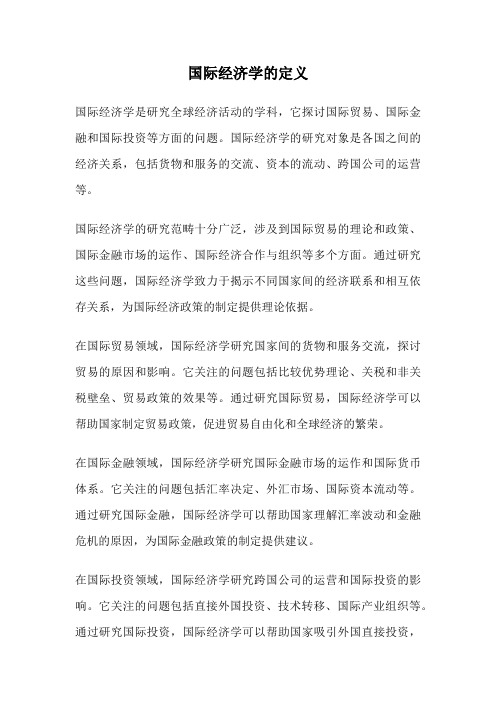
国际经济学的定义国际经济学是研究全球经济活动的学科,它探讨国际贸易、国际金融和国际投资等方面的问题。
国际经济学的研究对象是各国之间的经济关系,包括货物和服务的交流、资本的流动、跨国公司的运营等。
国际经济学的研究范畴十分广泛,涉及到国际贸易的理论和政策、国际金融市场的运作、国际经济合作与组织等多个方面。
通过研究这些问题,国际经济学致力于揭示不同国家间的经济联系和相互依存关系,为国际经济政策的制定提供理论依据。
在国际贸易领域,国际经济学研究国家间的货物和服务交流,探讨贸易的原因和影响。
它关注的问题包括比较优势理论、关税和非关税壁垒、贸易政策的效果等。
通过研究国际贸易,国际经济学可以帮助国家制定贸易政策,促进贸易自由化和全球经济的繁荣。
在国际金融领域,国际经济学研究国际金融市场的运作和国际货币体系。
它关注的问题包括汇率决定、外汇市场、国际资本流动等。
通过研究国际金融,国际经济学可以帮助国家理解汇率波动和金融危机的原因,为国际金融政策的制定提供建议。
在国际投资领域,国际经济学研究跨国公司的运营和国际投资的影响。
它关注的问题包括直接外国投资、技术转移、国际产业组织等。
通过研究国际投资,国际经济学可以帮助国家吸引外国直接投资,促进经济发展和产业升级。
除了上述方面,国际经济学还研究国际经济合作与组织。
国际经济合作通过国际机构和贸易协定等方式,促进各国间的经济合作和互利共赢。
国际经济组织则致力于提供经济政策建议、解决国际经济争端、推动全球经济治理等。
国际经济学是研究全球经济活动的学科,涵盖国际贸易、国际金融、国际投资以及国际经济合作与组织等多个领域。
它的研究对象是各国经济之间的关系和互动,旨在为国际经济政策的制定和实施提供理论支持。
通过深入研究国际经济学,我们可以更好地理解和应对全球经济的挑战与机遇。
- 1、下载文档前请自行甄别文档内容的完整性,平台不提供额外的编辑、内容补充、找答案等附加服务。
- 2、"仅部分预览"的文档,不可在线预览部分如存在完整性等问题,可反馈申请退款(可完整预览的文档不适用该条件!)。
- 3、如文档侵犯您的权益,请联系客服反馈,我们会尽快为您处理(人工客服工作时间:9:00-18:30)。
国际经济学(国际金融部分)导言国际金融是研究国际货币和资本运动规律及其影响因素的一门科学。
它涉及国际收支、外汇实务、国际借贷、国际风险、国际货币制度等方面的基本理论、基本知识和基本技能,是学习进行国际经济、贸易、金融、投资等各项涉外业务活动的基础。
当今世界经济一体化发展势不可挡,国际金融所发挥的作用和影响范围也越来越大。
国际金融市场将世界各国经济紧密的联系在一起。
因此,一国外汇市场上的风云变幻可能引起多方面的经济波动。
这些波动也可能对世界经济造成重要的影响。
同样,多种经济活动也会对国际金融形成多方面的影响。
学习和研究现代国际金融和实务具有非常重要的理论意义和实际意义。
第1章国际收支1.1 国际收支的基本概念1.1.1 国际收支的含义国际收支(Balance of Payments)即为国际间的外汇收支,反映一个国家在一定时期(通常为一年)内同其它国家在政治、经济、文化等方面交往所发生的外汇收支的总和。
一国的国际收支经常是不平衡的。
如果收支大于支出,有了盈余,这个差额就叫国际收支顺差(Surplus);如果支出大于收入,则出现亏损,这个差额就叫国际收支逆差(Deficit).一般在顺差之前,冠以“+”号(多省略);在逆差之前,冠以“-”号,或以红字书写表示国际收支发生了赤字。
国际货币基金组织(IMF)对国际收支下的定义是:“在一定时期内,一国居民对其他国家的居民所进行的全部经济交易的记录。
“居民”一词包括居留在一国的一切人(居住一年以上的)、各种机构和政府机关,实际上在该国从事经营的企业(如外国企业的分支机构)也算居民;逗留时间在一年以上的留学生,旅游者也算所在国居民。
而外交人员和外国部队系临时居住性质,不属于居民;国际性机构不属于任何一国居民。
1.2 国际收支平衡表1.2.1 国际收支平衡表的概念国际收支平衡表(Balance of Payments Statement)是指在一定时期内,对于一国与他国居民之间所进行的一切经济交易交易系统记录的报表。
国际收支平衡表是按照复式簿记的原理编制出来的表格。
一切国际金融交易都在国际收支平衡表上的借贷双方得到表示。
1.2 国际收支平衡表国际收支平衡表中每一笔具体的国际经济交易,在甚麽情况下列入贷方?在甚麽情况下列入借方?处理这一问题的原则是:任何国际金融交易,凡是使本国对外付款的列入借方,凡是使外国对本国付款或负有付款义务的列在贷方。
1.2 国际收支平衡表凡属下列情况的,均应记入借方;从外国获得商品与劳务(一般指进口);向外国私人或政府提供捐赠或援助等单方面转移;国内私人的国外资产增加或国外负债的减少;国内官方货币当局的国外资产增加或国外负债的减少。
凡属下列情况的均应记入贷方:向国外提供商品与劳务(出口);接受外国私人或政府的援助、捐赠等单方面转移;国内官方当局的国外资产的减少或国外负债的增加;国内私人的国外资产减少或国外负债的增加。
为了便于理解,现以商品进出口为例加以说明。
1. 美国一出口商出口了价值100000美元的商品,而对方以同等价值的另一种商品相抵,则美国的国际收支平衡表的贷方记入100000美元(商品出口),而借方记入100000美元(商品进口)。
2. 以存款支付贷款。
美国出口200000美元的商品到德国,德国进口商以他在美国的银行存款200000美元支付,则形成美国对国外的负债减少200000美元。
前者记入贷方(商品出口),后者记入借方(国外负债减少)。
3. 出口商接受外国货币的支付。
美国出口150000美元商品到英国,两国进出口商商定以相当于150000美元的英镑支付。
这样在美国的国际收支平衡表上贷方记入150000美元(商品出口),借方记入150000美元(国外资产增加,即美国的外汇持有量增加)。
将以上四笔业务登录在收支帐上,则为(单位:美元):1.3国际收支的影响及调节1.3.1 国际收支的平衡和失衡问题表1-7 国际收支局部差额关系表1.3.2 国际收支失衡的性质及影响1.周期性失衡(Cyclical Disequilibria)2.结构性失衡(Structure Disequilibria)3.货币性失衡(Money Disequilibria)4.所得性失衡(Income Disequilibria)5.偶然性失衡1.4国际收支调节理论与政策1.4.1国际收支的自动调节理论国际收支逆差--------黄金外流增加-------- 通货紧缩货币供应量减少---------对商品需求下降---------价格下跌---------出口成本下降出口增加---------黄金流入国际收支顺差---------黄金流入增加--------通货扩张货币供应量增加---------对商品需求增加---------价格上涨---------出口成本上涨---------黄金外流可见,国际收支的平衡是靠黄金量---价格作为调节国际收支的全过程.1.4.2 国际收支的弹性分析法如果以本国货币来记录国际收支,X表示出口数量,M表示进口数量,那麽一国的国际收支差额(B)就可写成:B=P x x-rP m M现以汇率贬值1%为例来考察汇率变动在国际收支调整中的作用。
根据弹性的定义,一方面由于出口外币价格下降1%,出口的数量就会增加çx%( çx为出口需求价格弹性的绝对值),这样,以本币表示的出口收入由于出口本币价格不变,会随出口数量的增加而等幅增加。
另一方面,进口外币价格不变,进口本币价格上升1%,进口数量就会减少çm%(çm为进口需求价格弹性的绝对值),这样因进口数量下降而引起的进口支出变动为-çm%×rP m M,而因本币价格上升而引起的进口本币支出变动为1%×rP m M.综合进出口收支的变动,可得到下式:△B=çx P x X/100£(1£çm)rP m M/100显然,如果çx p x x£¾(1£çm)rP m m,那麽国际收支就会由于汇率的贬值而改善:反之,则会恶化。
通常假定贬值前国际收支是均衡的,即P x x=rP m m,这样çx+çm£¾1马歇尔—勒纳条件(Marshall-Lerner Condition),是本国货币贬值能够改善国际收支的必要条件.也就是说,在进出口供给弹性无限大的情况下,只要一国进出口需求弹性的绝对值之和大于1,本国货币贬值就能改善国际收支状况.当然用外币来表示进出口收支,也同样可获得马歇尔—勒纳条件.还考虑进出口供给弹性时要满足:毕肯戴克-------罗宾逊--------梅茨勒条件[çxçm(e x+e m+1)+e x e m(çx+çm£1)]/(e x+çx)(e m+çm) £¾01.4.5 国际收支的调节政策1.外汇缓冲政策(建立外汇平准基金)2.财政金融政策外部宏观指标:国际收支内部宏观指标:通货膨胀率失业率国民生产总值增长率财政和金融政策配合使用3.利率政策4.汇率政策5.直接管理政策第2章外汇基本理论2.1 外汇的基本概念2.1.1 外汇的概念2.1.2 外汇的分类2.2 外汇的基本概念2.2.1外汇的概念和标价方法1.外汇的概念2.汇率的标价方法①直接标价法(Direct Quotation)用1个单位或100个单位的外国货币为标准,折算为一定数额的本国货币来表示汇率,这种标价方法称为直接标价法.②间接标价法.以1个或100个单位的本国货币为标准,折算为一定数量的外国货币来表示汇率的标价方法称为间接标价法.2.2.2 汇率的种类⑴按照银行买卖外汇划分,可分买入汇率﹑卖出汇率以及中间汇率.①买入汇率,又称买入价,是银行向客户买入外汇时使用的汇率.②卖出汇率,又称卖出价,是银行向客户卖出外汇时所使用的汇率.③中间汇率,买入汇率与卖出汇率的算术平均数为中间汇率.现举例说明上述3种汇率.人民币外汇牌价:1美元=人民币8.3107-8.3145又如:纽约外汇市场1美元=德国马克1.3857~1.3889⑵按银行的营业时间划分,有开盘汇率和收盘汇率.⑶按照国家对汇率管理的松紧程度划分,可分为官方汇率和市场汇率.⑷按制定汇率的方法不同,可以分为基本汇率和套算汇率.现举例说明套算方法.[例2-1] 当只报中间价时,套算方法比较简单.如:1美元=8.42人民币(中国报价)1英镑=1.62美元(伦敦外汇市场)则1英镑=1.62×8.42=13.64人民币一个是直接标价法,一个是间接标价法,套算时相乘.又比如:1美元=8.31人民币(中国报价)1美元=84.7日元(东京价格)则1日元=8.31/84.7=0.098人民币两个都是直接标价法或间接标价法,套算时相除.当买入价和卖出价都报出时,套算就要复杂一些.[例2-2] 设即期汇率行市为1美元=2.5715~2.5725马克(德国)1英镑=1.4600~1.4610美元(英国)则英镑对马克的汇率为买入汇率:2.5715×1.4600=3.7544卖出汇率:2.5725×1.4610=3.7584即1英镑=3.7544~3.7584马克一个采用直接标价法,一个是间接标价法,套算时进行“同边相乘”,即买入外汇相乘是套算汇率的买入汇率,卖出汇率相乘是套算出的卖出汇率.[例2-3] 假设即期外汇行市为1美元=2.5715~2.5725马克(德国)1美元=235.50~223.60日元(日本)如果要套算马克对日元的汇率,可以先算出马克对美元的汇率:1马克=1/2.5725~1/2.5715美元1美元=223.50~223.60日元这样,原来相同的标价法换算成了不同的标价法,再进行“同边相乘”,得出:马克买入汇率为223.50/2.5725=86.88马克卖出汇率为223.60/2.5715=86.95即1马克=86.88~86.95日元⑸根据外汇交易不同的交割期限,有即期汇率和远期汇率.⑹根据资金性质和用途,可分为贸易汇率和金融汇率.⑺根据汇率有无差别规定和适用范围,有单一汇率和多元汇率.⑻根据交易对象的不同,有银行同业汇率和银行对顾客汇率.⑼根据不同的汇兑方式,有电汇汇率、信汇汇率、票汇汇率。
2.2.3 汇率报价银行对客户的外汇报价,是在市场汇率的基础上,考虑到成本和利润因素,风险因素和利息因素后综合确定的.2.3 汇率的决定2.3.1 金本位制(Gold Standard System)下汇率的决定在金本位制度下,金币所含有的一定重量和成色的黄金叫做含金量(Gold Content).黄金含量代表着金币所具有的价值.实行金本位制度的国家之间,把各自国家的金铸币含金量进行对比,建立铸币平价(Mint Par),就确定了不同货币间的官方汇率(Official Rate).1英镑所包含的黄金量在英美之间输送费用为0.03美元(运输费,保险费,包装费,手续费, 在途利息)计算英镑和美元之间的铸币平价为113.0016/23.22=4.86651英镑=4.8665美元铸币平价是确定汇率的基础.市场上的实际汇率,受外汇供求状况的影响,围绕铸币平价为中心,经常发生波动.这种波动,是以黄金输送点(Gold Transport Points)为界限的.2.3.3 浮动汇率制度下汇率的决定利率平价理论e f /e s(1+i DM)=1+i$e f /e s=(1+i$)/(1+i DM)(e f-e s)/e s=(i$-i DM)/(1+i DM)当1+i→1时,可忽略不计,即可得到(e f-e s)/e s≈i$-i DM2.3.4 影响汇率变动的主要因素1.国际收支2.通货膨胀的影响3.利率因素4.政策因素5.其它因素:经济增长率的差异,外汇市场的心理预期,外汇投机活动等。
